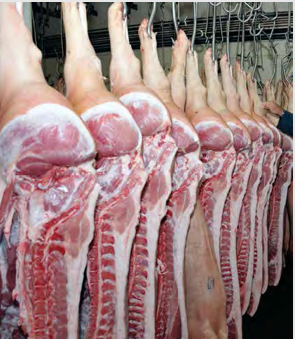Whole Carcass Pork Quality
Bob Kemp, VP Genetic Programs and R&D
As most industry participants know, the USDA Agricultural Marketing Service is seeking comment on the proposed changes to the standards of pork carcass grades (https://www.federalregister.gov/documents/2017/10/23/2017-22934/united-states-standards-for-grades-of-pork-carcasses) . There will be different opinions on the value of these proposed changes, especially as it relates to the loin color and marbling score specifications. One undeniable and important value is that the proposed grading changes will provide a routine, consistent and effective method to pass information on pork quality to the producer. This information, in the hands of the producer can then be used to develop knowledge on how to influence pork quality and its impact on profitability of their operations. Enhanced producer knowledge is always good for the industry.
 Historically the loin has been considered the most valuable primal and, therefore, the focus of measuring pork quality. However, in the last year the value of other primals, namely bellies have increased significantly more than loins. Additionally, the ham primal is an important part of carcass value despite its lower price per kg because it represents more than 20% of the hot carcass weight. So, one obvious question is the importance of quality of primals other than the loin.
Historically the loin has been considered the most valuable primal and, therefore, the focus of measuring pork quality. However, in the last year the value of other primals, namely bellies have increased significantly more than loins. Additionally, the ham primal is an important part of carcass value despite its lower price per kg because it represents more than 20% of the hot carcass weight. So, one obvious question is the importance of quality of primals other than the loin.
There have been numerous studies about pork quality for specific primals but few have looked at the relationship between pork quality of different primals within the same carcass. Arkfeld et al. (2016) published a study with the objective of “determining the correlation between fresh loin quality and fresh belly or fresh and cured ham quality”. This was a large study, in part funded by the National Pork Board with over 7,000 carcasses evaluated depending on which trait(s) and/or primal was being measured. The main conclusion was that loin quality traits explained relatively little variation in belly, fresh ham or cured ham quality. At first glance, this seems disappointing but as noted by the authors there are large differences in the chilling rates between loins and hams and the percentage of lipid between bellies and loins that could contribute to these results. Additionally, many of the correlations between loin quality traits and traits measured in the fresh belly, fresh or cured ham were favourable but not large. The authors concluded that a carcass with a high-quality loin may not necessarily yield a high-quality belly or ham and that to understand whole carcass quality one should measure quality of the loin, ham and belly primals individually. So, the results are not so disappointing and clearly indicate the need to fully understand the factors affecting pork quality, in all primals, including genetic factors.
Genesus Inc. is committed to carcass and meat quality improvement and has conducted a weekly carcass and meat quality program since 1998. In addition to the loin, other primals are measured for quality. Genesus Inc. continually investigates technologies to accurately measure pork quality. Improving pork quality, in economic balance with other important traits, will ensure that consumers have the ultimate eating experience and contribute to driving increased pork demand.
References
Arkfeld, E.K. et al. 2016. Pork loin quality is not indicative of fresh belly or fresh and cured ham quality. J. Anim. Sci. 94:5155-5167. doi:10.2527/jas2016-0886
Categorised in: Featured News, Global Tech
This post was written by Genesus



